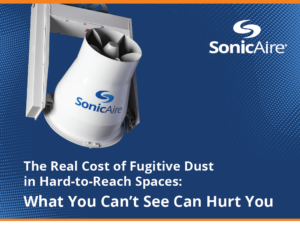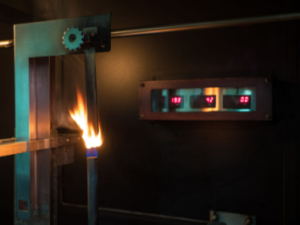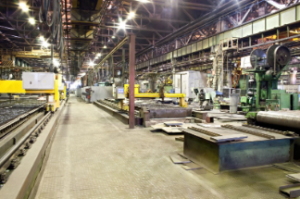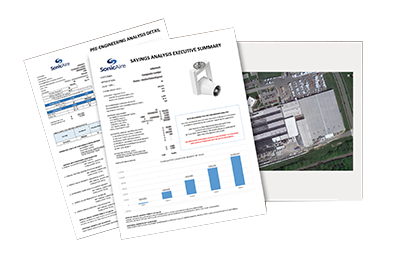Understanding the Impact on Workplace Safety under the Occupational Health and Safety Act of 1970
Excessive dust coverage in industrial environments can pose severe risks to employees and facilities. It compromises health protocols and cleanliness standards and violates health regulations set forth by governing bodies such as the Occupational Safety and Health Administration (OSHA) and the National Fire Protection Association (NFPA). In this blog, we dig a little deeper into:
- The regulations regarding dust control.
- How too much dust affects workplace safety.
- What it means for health regulations.
- How you can fix it.
Overview of the OSHA Act of 1970
 The Occupational Safety and Health Act of 1970 changed the landscape of workplace safety in America. Although many find OSHA’s regulations to be overbearing, it’s prevented and reduced accidents in the workplace by a significant margin since its introduction. In a nutshell, the OSH Act mandates employers to ensure that workplaces are free of hazards that could potentially lead to serious employee harm. This implies identifying and correcting any existing hazards and developing measures to prevent the occurrence of new hazards. While some dangers, such as broken machines or spilled chemicals, are easily apparent, others, like dust, can go unnoticed, yet they present significant risks to employee health.
The Occupational Safety and Health Act of 1970 changed the landscape of workplace safety in America. Although many find OSHA’s regulations to be overbearing, it’s prevented and reduced accidents in the workplace by a significant margin since its introduction. In a nutshell, the OSH Act mandates employers to ensure that workplaces are free of hazards that could potentially lead to serious employee harm. This implies identifying and correcting any existing hazards and developing measures to prevent the occurrence of new hazards. While some dangers, such as broken machines or spilled chemicals, are easily apparent, others, like dust, can go unnoticed, yet they present significant risks to employee health.
Fugitive dust, created during manufacturing processes and often visible to the naked eye as it escapes normal filtration methods, can cause allergies or respiratory problems when workers inhale it in large quantities. Therefore, controlling and monitoring dust levels in facilities is crucial to prevent its buildup. Employers who fail to address known hazards like combustible and fugitive dust may face legal action, including lawsuits and fines if their workers become ill. Additionally, such negligence can ruin a company’s reputation as a safety-conscious organization.
The most effective way to mitigate fugitive dust hazards is through proactive measures. However, the standard for most workplaces is reactive. Typical reactive measures include regularly cleaning the workplace, using specialized equipment to filter the air, and ensuring employees know the risks and how to protect themselves. Conversely, by staying ahead of potential hazards and utilizing proactive measures like dust control fans, we can maintain healthy and safe workplaces that promote employee well-being and productivity.
Excessive Dust as a Workplace Hazard
As a facility manager, you should always be aware of excessive fugitive dust in the workplace. It’s not just about how it looks dirty and messy; it’s a real problem that affects safety, how well things run, and compliance with OSHA regulations.
The National Fire Protection Association (NFPA) provides a critical benchmark, defining excessive dust as any accumulation reaching a threshold of 1/32 inch, covering more than 5% of the floor area. Understanding this is crucial for keeping people and things safe in places like factories.
So, why is there so much emphasis on dust?
First, breathing fugitive dust into your lungs can cause several problems, from irritating coughs to serious issues like asthma. In addition to this, some dusts are highly combustible. Should enough combustible dust become suspended in the air, any ignition source in your facility can become the starting point for a tragic event. Industries that produce dust with a high MEC (Minimum Explosible Concentration)—should take special care to ensure dust doesn’t accumulate on surfaces or in the air. .
Fugitive dust can also make it hard to see, leading to accidents and slowing things down at work. And it’s not just about people; it can affect machines, too. Dust particles can get into the fine inner workings of equipment, causing damage and making them break down more often. That means more money spent on preventive maintenance and fixing problems and less time getting work done.
Being proactive about fugitive dust control is the most surefire way to keep your employees safe and your facility compliant. That means ditching cyclical cleaning methods like blowdowns and vacuuming and trading those costly approaches for a proactive approach like using dust control fans in conjunction with dust collectors. By adopting this methodology, businesses can keep their workplaces safe, running smoothly, and in compliance with safety standards.
Impact on Health Protocols
At SonicAire, we take workplace health protocols for our customers very seriously. Our team of engineers have designed our fans to specifically combat the potential hazard of combustible dust while also improving employee health. After all, dust that lingers in the air is always a concern for employee respiration. And no one likes wearing a respirator all day.
Dust settles on surfaces, people, equipment, and even in ventilation systems throughout the workplace. It affects how things look and creates a haven for allergens and insects.
Cleaning up all this dust is no small task and can cause significant disruptions to daily operations. It requires thorough and frequent cleaning, specialized equipment, and trained personnel, all of which take time and resources away from core business activities. It’s not just what you’re spending, though. It’s also forcing you to shut down production (lost potential profits) and paying overtime or holiday pay to employees that have to clean. Plus, forcing all of that dust all at once onto your production equipment from the ceiling is tough on the machines you use.
Given these consistent concerns with dust, businesses must proactively address excessive dust accumulation. Implementing robust dust control strategies, like the automated solutions offered by SonicAire dust control fans, automates dust management while maintaining an always compliant and safe facility. With a proactive solution like SonicAire, you can mitigate the risks associated with dust accumulation, and not have to worry about lost profits. You’ll also be creating a safer and healthier workplace while fostering a culture of safety and resilience in the face of health hazards.
Violations of Health Regulations
These regulations require employers to keep workplaces safe and facility dust levels in check. They spell out extremely specific rules about acceptable dust accumulation levels, ventilation, protective gear, and overall workplace safety. Ignoring these rules doesn’t just mean cutting corners—it also puts people’s health and safety in danger and breaks the law.
In 2016, the NFPA published its standard on the fundamentals of combustible dust, NFPA 652. After years of practical application, multiple amendments, and subsequent publications, the NFPA consolidates all combustible dust standards into the pending NFPA 660, due sometime in 2025.
A business that breaks these rules could face hefty fines and penalties. OSHA, for instance, keeps a close eye on workplaces and doesn’t hesitate to hand out penalties for safety violations. And if things go really wrong and someone gets hurt or sick because of dust-related hazards, businesses could find themselves in expensive legal battles, facing lawsuits, settlements, and damage to their reputation and finances.
But proactive dust control isn’t just about the immediate benefits.
Ignoring health regulations can also damage a business’s reputation and trust among customers and stakeholders. With increased attention to workplace safety, thanks to the media and social activism, companies that don’t follow the rules risk losing the trust and loyalty of their customers, hurting their bottom line and competitiveness in the long run.
Proactive risk management means thorough risk assessments, effective dust management strategies, regular employee training, and close monitoring of compliance efforts. By creating a culture of safety and accountability, businesses can protect their workers, uphold their ethical responsibilities, and avoid the costly consequences of ignoring health regulations.
Dust Control Solutions
Addressing excessive dust coverage requires effective dust control solutions. SonicAire offers innovative dust control technology known as BarrierAire™. This game-changing solution prevents combustible dust issues before they escalate, ensuring safety and regulatory compliance. SonicAire’s engineers work closely with facility managers and production business owners to customize fan layouts based on specific needs, delivering immediate benefits to their businesses.
BarrierAire™ technology utilizes high-velocity horizontal airflow to prevent fugitive dust from accumulating in critical areas, reducing the risk of fires, explosions, and other safety hazards. By implementing this comprehensive dust control solution, facilities can create safer working environments while maintaining compliance with health regulations and avoiding potential legal and financial consequences.
Importance of Proactive Dust Management
Dust Control Solutions
Addressing excessive fugitive dust requires effective and reliable dust control solutions. SonicAire offers innovative dust control technology known as BarrierAire™. This game-changing solution prevents overhead combustible dust issues before they escalate, ensuring safety and regulatory compliance. SonicAire’s engineers work closely with facility managers and business owners to customize fan layouts based on specific needs, delivering immediate benefits to their businesses.
BarrierAire™ technology utilizes high-velocity horizontal airflow to prevent fugitive dust from accumulating in critical areas, reducing the risk of fires, explosions, and other safety hazards. By implementing this comprehensive dust control solution, facilities can create safer working environments while maintaining compliance with health regulations and avoiding potential legal and financial consequences.
Importance of Proactive Dust Management
At SonicAire, we talk a lot about the benefits of our unique, proactive approach to dust management. You likely already know several ways to manage dust in your facility, but we’re willing to bet they are all reactive – vacuuming, blowdowns, and the like. These solutions are like treading water. They work ok, but if you ever let your efforts wane for any reason, you could face catastrophic consequences. They are also dangerous because they create dust clouds in your facility, which jeopardizes your staff and property.
Controlling fugitive dust helps keep everyone safer. Combustion, deflagration, and the resulting injuries or death aren’t concerns when you have a practical solution that prevents buildup. Less dust in the air means fewer respiratory problems and allergies, which makes for a much nicer workplace.
It’s not just about health and safety, though. It’s also about making operations run smoother. A clean and dust-free workspace helps employee morale, allowing them to stay focused and finish their work without distractions.
And you can’t forget about the money side of production. Taking care of dust now can save you a lot of cash in the long run. When you keep your equipment and machinery free of dust, they last longer and work better, so you don’t have to spend as much on repairs or replacements. By staying ahead of dust buildup, you’re also dodging hefty fines and penalties from regulators who want to ensure we follow the rules.
When you invest in SonicAire a dust control fan system, you’re looking out for employees’ safety and setting yourself up for success. It’s all about creating a workplace where everyone can thrive, be productive, and feel good about what they’re doing while keeping their eyes on the prize of staying compliant and responsible.
Prioritize Comprehensive Dust Control Solutions for a Safe and Compliant Workplace
Ensuring your workplace is safe and maintains compliance with the OSH Act of 1970 is critical. Too much dust can interfere with health protocols and violate regulations from organizations like OSHA and the NFPA. But don’t worry—SonicAire’s dust control solutions will keep you safe and compliant. We guarantee it.
Getting on top of dust control is crucial if you’re in charge of a facility or a business dealing with production. That’s where SonicAire’s BarrierAire™ technology comes in. It’s a real game-changer for stopping dust from causing problems like fires. Plus, it helps keep things safe, saves money, and keeps us all following the rules.
Ready to create a safe and compliant workplace? Request a quote from SonicAire today and discover the power of effective dust control.
Understanding the Impact on Workplace Safety under the OSH Act of 1970
Excessive dust coverage in industrial environments can pose severe risks to employees and facilities. It compromises health protocols and cleanliness standards and violates health regulations set forth by governing bodies such as the Occupational Safety and Health Administration (OSHA) and the National Fire Protection Association (NFPA). In this blog, we dig a little deeper into:
- The regulations regarding dust control.
- How too much dust affects workplace safety.
- What it means for health regulations.
- How you can fix it.
Overview of the OSH Act of 1970
The Occupational Safety and Health Act of 1970 changed the landscape of workplace safety in America. Although many find OSHA’s regulations to be overbearing, it’s prevented and reduced accidents in the workplace by a significant margin since its introduction. In a nutshell, the OSH Act mandates employers to ensure that workplaces are free of hazards that could potentially lead to serious employee harm. This implies identifying and correcting any existing hazards and developing measures to prevent the occurrence of new hazards. While some dangers, such as broken machines or spilled chemicals, are easily apparent, others, like dust, can go unnoticed, yet they present significant risks to employee health.
Fugitive dust, created during manufacturing processes and often visible to the naked eye as it escapes normal filtration methods, can cause allergies or respiratory problems when workers inhale it in large quantities. Therefore, controlling and monitoring dust levels in facilities is crucial to prevent its buildup. Employers who fail to address known hazards like combustible and fugitive dust may face legal action, including lawsuits and fines if their workers become ill. Additionally, such negligence can ruin a company’s reputation as a safety-conscious organization.
The most effective way to mitigate fugitive dust hazards is through proactive measures. However, the standard for most workplaces is reactive. Typical reactive measures include regularly cleaning the workplace, using specialized equipment to filter the air, and ensuring employees know the risks and how to protect themselves. Conversely, by staying ahead of potential hazards and utilizing proactive measures like dust control fans, we can maintain healthy and safe workplaces that promote employee well-being and productivity.
Excessive Dust as a Workplace Hazard
As a facility manager, you should always be aware of excessive fugitive dust in the workplace. It’s not just about how it looks dirty and messy; it’s a real problem that affects safety, how well things run, and compliance with OSHA regulations.
The National Fire Protection Association (NFPA) provides a critical benchmark, defining excessive dust as any accumulation reaching a threshold of 1/32 inch, covering more than 5% of the floor area. Understanding this is crucial for keeping people and things safe in places like factories.
So, why is there so much emphasis on dust?
First, breathing fugitive dust into your lungs can cause several problems, from irritating coughs to serious issues like asthma. In addition to this, some dusts are highly combustible. Should enough combustible dust become suspended in the air, any ignition source in your facility can become the starting point for a tragic event. Industries that produce dust with a high MEC (Minimum Explosible Concentration)—should take special care to ensure dust doesn’t accumulate on surfaces or in the air. .
Fugitive dust can also make it hard to see, leading to accidents and slowing things down at work. And it’s not just about people; it can affect machines, too. Dust particles can get into the fine inner workings of equipment, causing damage and making them break down more often. That means more money spent on preventive maintenance and fixing problems and less time getting work done.
Being proactive about fugitive dust control is the most surefire way to keep your employees safe and your facility compliant. That means ditching cyclical cleaning methods like blowdowns and vacuuming and trading those costly approaches for a proactive approach like using dust control fans in conjunction with dust collectors. By adopting this methodology,, businesses can keep their workplaces safe, running smoothly, and in compliance with safety standards.
Impact on Health Protocols
At SonicAire, we take workplace health protocols for our customers very seriously. Our team of engineers have designed our fans to specifically combat the potential hazard of combustible dust while also improving employee health. After all, dust that lingers in the air is always a concern for employee respiration. And no one likes wearing a respirator all day.
Dust settles on surfaces, people, equipment, and even in ventilation systems throughout the workplace. It affects how things look and creates a haven for allergens and insects.
Cleaning up all this dust is no small task and can cause significant disruptions to daily operations. It requires thorough and frequent cleaning, specialized equipment, and trained personnel, all of which take time and resources away from core business activities. It’s not just what you’re spending, though. It’s also forcing you to shut down production (lost potential profits) and paying overtime or holiday pay to employees that have to clean. Plus, forcing all of that dust all at once onto your production equipment from the ceiling is tough on the machines you use.
Given these consistent concerns with dust, businesses must proactively address excessive dust accumulation. Implementing robust dust control strategies, like the automated solutions offered by SonicAire dust control fans, automates dust management while maintaining an always compliant and safe facility. With a proactive solution like SonicAire, you can mitigate the risks associated with dust accumulation, and not have to worry about lost profits. You’ll also be creating a safer and healthier workplace while fostering a culture of safety and resilience in the face of health hazards.
Violations of Health Regulations
These regulations require employers to keep workplaces safe and facility dust levels in check. They spell out extremely specific rules about acceptable dust accumulation levels, ventilation, protective gear, and overall workplace safety. Ignoring these rules doesn’t just mean cutting corners—it also puts people’s health and safety in danger and breaks the law.
In 2016, the NFPA published its standard on the fundamentals of combustible dust, NFPA 652. After years of practical application, multiple amendments, and subsequent publications, the NFPA consolidates all combustible dust standards into the pending NFPA 660, due sometime in 2025.
A business that breaks these rules could face hefty fines and penalties. OSHA, for instance, keeps a close eye on workplaces and doesn’t hesitate to hand out penalties for safety violations. And if things go really wrong and someone gets hurt or sick because of dust-related hazards, businesses could find themselves in expensive legal battles, facing lawsuits, settlements, and damage to their reputation and finances.
But proactive dust control isn’t just about the immediate benefits.

Ignoring health regulations can also damage a business’s reputation and trust among customers and stakeholders. With increased attention to workplace safety, thanks to the media and social activism, companies that don’t follow the rules risk losing the trust and loyalty of their customers, hurting their bottom line and competitiveness in the long run.
Proactive risk management means thorough risk assessments, effective dust management strategies, regular employee training, and close monitoring of compliance efforts. By creating a culture of safety and accountability, businesses can protect their workers, uphold their ethical responsibilities, and avoid the costly consequences of ignoring health regulations.
Dust Control Solutions
Addressing excessive fugitive dust requires effective and reliable dust control solutions. SonicAire offers innovative dust control technology known as BarrierAire™. This game-changing solution prevents overhead combustible dust issues before they escalate, ensuring safety and regulatory compliance. SonicAire’s engineers work closely with facility managers and business owners to customize fan layouts based on specific needs, delivering immediate benefits to their businesses.
BarrierAire™ technology utilizes high-velocity horizontal airflow to prevent fugitive dust from accumulating in critical areas, reducing the risk of fires, explosions, and other safety hazards. By implementing this comprehensive dust control solution, facilities can create safer working environments while maintaining compliance with health regulations and avoiding potential legal and financial consequences.
Importance of Proactive Dust Management
At SonicAire, we talk a lot about the benefits of our unique, proactive approach to dust management. You likely already know several ways to manage dust in your facility, but we’re willing to bet they are all reactive – vacuuming, blowdowns, and the like. These solutions are like treading water. They work ok, but if you ever let your efforts wane for any reason, you could face catastrophic consequences. They are also dangerous because they create dust clouds in your facility, which jeopardizes your staff and property.
Controlling fugitive dust helps keep everyone safer. Combustion, deflagration, and the resulting injuries or death aren’t concerns when you have a practical solution that prevents buildup. Less dust in the air means fewer respiratory problems and allergies, which makes for a much nicer workplace.
It’s not just about health and safety, though. It’s also about making operations run smoother. A clean and dust-free workspace helps employee morale, allowing them to stay focused and finish their work without distractions.
And you can’t forget about the money side of production. Taking care of dust now can save you a lot of cash in the long run. When you keep your equipment and machinery free of dust, they last longer and work better, so you don’t have to spend as much on repairs or replacements. By staying ahead of dust buildup, you’re also dodging hefty fines and penalties from regulators who want to ensure we follow the rules.
When you invest in SonicAire a dust control fan system, you’re looking out for employees’ safety and setting yourself up for success. It’s all about creating a workplace where everyone can thrive, be productive, and feel good about what they’re doing while keeping their eyes on the prize of staying compliant and responsible.
Prioritize Comprehensive Dust Control Solutions for a Safe and Compliant Workplace
Ensuring your workplace is safe and maintains compliance with the OSH Act of 1970 is critical. Too much dust can interfere with health protocols and violate regulations from organizations like OSHA and the NFPA. But don’t worry—SonicAire’s dust control solutions will keep you safe and compliant. We guarantee it.
Getting on top of dust control is crucial if you’re in charge of a facility or a business dealing with production. That’s where SonicAire’s BarrierAire™ technology comes in. It’s a real game-changer for stopping dust from causing problems like fires. Plus, it helps keep things safe, saves money, and keeps us all following the rules.
Ready to create a safe and compliant workplace? Request a quote from SonicAire today and discover the power of effective dust control.

GET YOUR FREE GUIDE:
The Real Cost of Fugitive Dust in Hard-to-Reach Spaces
What You Can’t See Can Hurt You
To help protect your workplace, we’ve compiled the following resource, The Real Cost of Fugitive Dust in Hard-to-Reach Spaces: What You Can’t See Can Hurt You. In it, we identify seven ways fugitive dust is likely impacting your facility and its profitability.
These costs go beyond housekeeping and explain why you should be preventing dust buildup to protect the bottom line, not just to stay in compliance.





